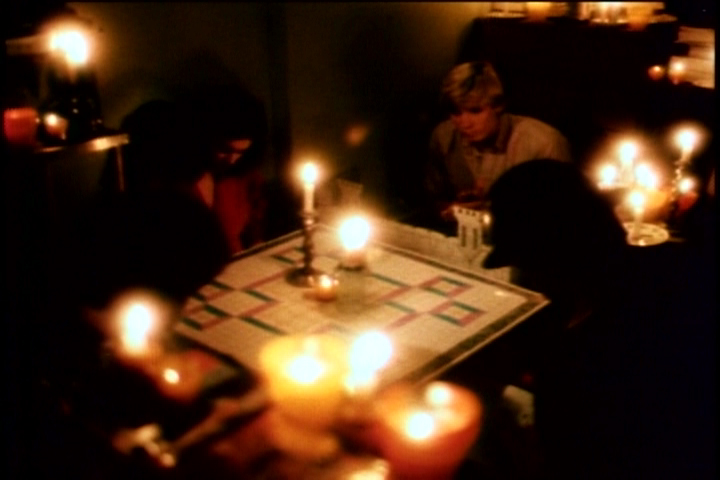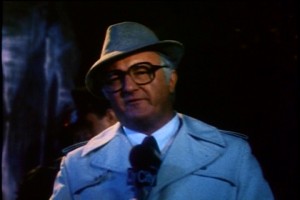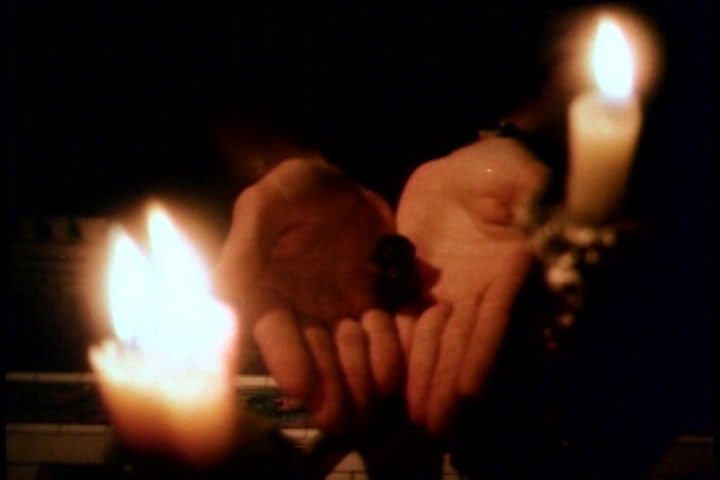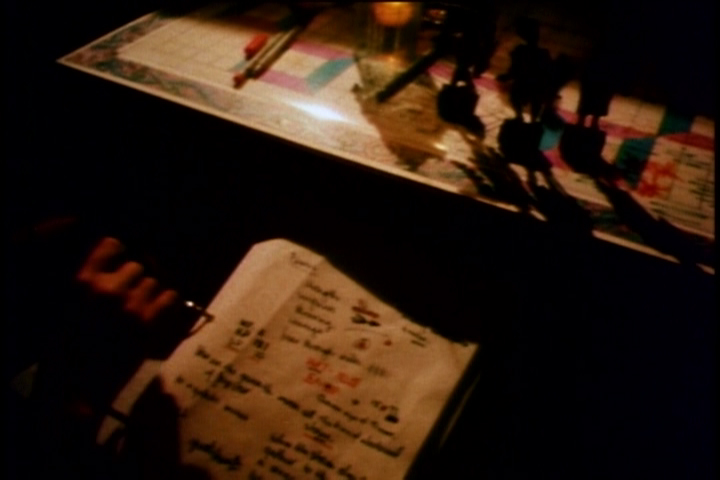(As I mentioned in part I, I’m reverse engineering the rules to the RPG from the Tom Hanks blockbuster Rona Jaffe’s Mazes and Monsters.)
Here’s the first scene where we see a Mazes and Monsters game being played! And, as we’d expect in this film, which is so steeped in RPG rules that it is practically a Mazes and Monsters manual, we can get a lot of rules information from just the first frame of this scene.
First of all, we can see that this game is played on a board. (I think? It could also be just an awesome coffee table that happens to have a dungeon-like pattern.) Second, we see that there are candles. Lots and lots of candles. Finally, we see what looks like a GM’s screen, shaped like a sweet castle!
Notable for their absence: dice. None of the players have any dice sitting in front of them. What kind of game is this? What do the players stack when they are bored? The only possible answer is NOTHING, because IN MAZES AND MONSTERS YOU DO NOT GET BORED!!!
If anyone had any lingering doubts about Mazes and Monsters being an entirely separate game from D&D, those doubts should be dispelled. Most editions of D&D have some sentence that is a variation on the following: All you need to play this game is a few friends, this book, dice — and imagination!
Imagine that sentence as it would appear in the Mazes and Monsters rulebook:
All you need to play this game is at least three friends, this book, NO dice, a board (or possibly a coffee table), and some personal problems you want to work out. Hundreds of candles are optional but highly recommended.
OK, let’s get to some dialogue!
Hold up a minute. Guys, before we continue, I just cannot get my mind off that game board (or coffee table). What could it be? We can clearly see that while there are lines on it, they are regular and not mazelike. It’s symetrical and has no dead ends. It just can’t be the map of a maze. But there are grid lines. The only conclusion I can come to is that the board is used as a condition tracker. Players use lead miniatures or counters to represent their characters, and put them in various places on the board to represent their current status.
Maybe the outer area of the board represents the characters when they are in average health. The eight small boxes might be for tracking conditions – poisoned, confused, “in a fantasy”, etc. What about the middle plus-shaped area? It might be where you put your players when they “win” (find the treasure).
Hmm… although if these were all areas for separate condition, you’d expect to see text in there: “poisoned”, etc. From the screenshot, it doesn’t look like that’s the case.
The other possibility is that the squares and lines on the boards mean nothing. That would render the whole game a hollow sham, and make a mockery of this enterprise to figure out its rules. I think we can safely rule out that possibility.
OK, I have one more idea. All the little squares are for marking the same condition. There are 8 of them because the game can support up to 8 players in addition to the GM.
Mazes and Monsters is a game for 4 to 9 players.
Whatever this condition is, it must be central to the game. Let’s use texual evidence to figure out what it is.
REPORTER: Mazes and Monsters is a fantasy role-playing game in which players create imaginary characters. These characters are then plunged into a fantasy world of imagined terrors. The point of the game is to amass a fortune without being killed. It’s kind of a psychodrama, you might say, where these people deal with problems in their lives by acting them out.
Mazes and Monsters is a psychological game. The main bad thing that can happen to characters is to be plunged into imagined terrors – and, as we know from the tragedy of Tom Hank’s real M&M-fueled insanity – to be trapped in a world where fact and fantasy are indistinguishable.
I have the perfect word to describe this state! “MAZED.” It means “stupified; bewildered; dazed; perplexed”. It has the RPG connotations of a confused state in which you are unable to act effectively; the psychological connotation of being lost and unsure of what’s going on; and, even better, it is the word MAZED. If my guess is correct, and this was the word Rona Jaffe used in the original Mazes and Monsters manual, then she was the greatest genius of all time.
Let’s go ahead and put this in the glossary!
MAZED: A state where a character is trapped in a terrifying fantasy from which he cannot easily escape. The imagined terrors are usually related to problems in the player’s own life. While in this state, the character can take no effective actions. A Mazed character’s gamepiece is placed in an empty Maze Prison square on the Mazes and Monsters gameboard.
Now that we’ve figured out what the 8 small squares are, let’s re-evaluate the large plus-shaped area in the middle of the board. If the small squares are Maze Prisons, where characters are trapped in individual fantasies, then the central zone must be a communal area where all the characters go when they invoke the 9th-level ability to “create their own fantasy!” In this area, your friends can help you deal with your problems. It is, I expect, is where the real-life healing happens.
OK, we’ve got all we can out of frame 1 of the scene. Let’s press Play and see what happens.
Rule 0
At the beginning of the session, as the other players meditate, Blondie recites, in tones which can only be described as ‘sepulchral’: “I am the Maze Controller. The god of this universe I have made. The absolute authority. Only I know the perilous course which you are about to take. Your fate… is in my hands.” At the ellipsis, the he opens his hands, revealing his symbol of authority: 2 d12s.
WHA HUH????
Yes, for realz – you can’t see it very well in this screenshot, but watching the movie, you can see them roll a little and they are definitely d12s.
Is Rona Jaffe still alive? She should be knighted, just on the basis of this screenshot alone. Long has the world thought that a d12-based RPG system was TOO INSANE TO ATTEMPT. Now it seems that it’s always been there, ever since Mazes and Monsters‘ 1982 release date, if not before. Tom Hanks has held this secret in his heart all this time, and he never told us. He never told us.
OK, let’s pause to write up some rules!
One special player of a Mazes and Monsters game is called the Maze Controller. The Maze Controller is a sort of referee, or, to put it another way, a god. The absolute authority. Only HE knows the perilous course which the players are about to take. Their fate… is in his hands.
At the start of every session, the Maze Controller should take the opportunity to reassert his dominance over the other players by fixing each of them with a gimlet stare, and, while flourishing his dice, declaim: “I am the Maze Controller. The god of this universe I have made. The absolute authority. Only I know the perilous course which you are about to take. Your fate… is in my hands.”
While the Maze Controller speaks, all players should bow their heads in silent thanksgiving for the mystical power of the Maze Controller.
Any game which starts without this ritual is not an official Mazes and Monsters game and the participants will be awarded no Levels. Furthermore, any real-life problems which players work out in such an unsanctioned game are to be considered UNSOLVED.
That’s a good start. But what about those d12s? We can’t just gloss over that. D12s appear to the the only dice the Maze Controller has, and none of the players have any dice at all. We need to come up with a way to explain the fact that Mazes and Monsters is based solely on the most absurd of all dice.
The Base Mechanic
Mazes and Monsters is a d12 system. This means that it uses the d12 to resolve any combat, scenario, fantasy, or anything else requiring a check. The players never touch the dice; the Maze Controller makes all rolls — secretly, behind his sweet castle-shaped DM screen.
To determine the difficulty of the check, the Maze Controller assigns it a number. This number is called the Roll-Over Number for Accomplishment, or RONA.
When the Maze Controller needs to generate a random number, he rolls one or two d12s. Numbers from 1 to 10 are treated normally. 11s are treated as fumbles; for each 11 rolled, the Maze Controller rolls an extra d12 and subtracts that roll from the previous total. 12s are treated as critical successes; for each 12 rolled, the Maze Controller adds 10 to the roll and then rolls an extra d12. This mechanic is known as an “exploding die roll” and will be all the rage in about 10 years.
Because this is the 80’s, here’s the same information again, in chart form; and because this game is insane, it’s also presented in nursery-rhyme singsong.
DIE ROLL ACTION 1-10 – 11 subtract a reroll: you’re that far in the hole 12 Add 10, roll again
This is all supposition, of course, but I cannot think of any other mechanic by which you could rely solely on d12s.
Wow, we got a lot done today! We learned some of the important ritual activities surrounding the game, determined some of the imagined terrors that await characters, and figured out the game’s core mechanic. And we’re not even halfway through this scene! Next time, we’ll see what else we can glean from the scene. As a preview, here’s a preview of a CHARACTER SHEET! and MINIS!
Tags: mazesandmonsters











“This number is called the Roll-Over Number for Accomplishment, or RONA.”
genius
[…] On to Part 2 […]
I couldn’t figure out an acronym for HANKS.
A game called The Everlasting was d12 based. But M&M must have come first.
I know you’re retro-cloning Mazes and Monsters (please don’t confuse with the excellent Mazes and Minotaurs) for comedy purposes. To me, though, the playing surface looks like a (rather abstract) map of some sort of keep rather than a traditional board game board. I’m with you, though. I’d never risk spilling wax (or cola) on an expensive poster-sized game map by putting lighted candles (or drink glasses) on it. I mean, when was the last time you bought an RPG that provided a color poster-sized map on good, heavy paper? The closest I’ve come are the map packs for Hero Clix.
D12s for gaming purposes? Eh, why not? Tri-Stat DX gave us the option, and I don’t really see much of a difference between a pair of D12s and the handful of D6s that several “old school” non-D&D games used.
> Long has the world thought that a d12-based RPG system was TOO INSANE TO ATTEMPT.
In fact, only ONE MAN ALIVE could conceive of a 2d12-based system SO CRAZY IT JUST MIGHT WORK.
http://www.amazon.com/Thousand-Suns-RGG1000-James-Maliszewski/dp/0979636116
An unconscious homage to M&M?
Some things to add:
1. Cartoon Action Hour uses d12s exclusively.
2. Rona Jaffe died in December of 2005.
3. You may wish to consider reading the novel that the movie was based on for more information. I read it about 10 years ago, so I don’t remember how much game-specific info was in it. You should be able to find a copy for cheap on Amazon, or at your local Goodwill store. I’ve seen several copies at my Goodwill over the years. If I see another one here, I could get it for you and mail it to you, if you like. Let me know. (Just a warning – it’s hard to get through. It’s actually more like a romance novel than a thriller.)
4. Great posts, by the way. I’m enjoying them a lot, and I’ve mentioned them on my blog – http://www.theescapist.com/blog
Roger:
>In fact, only ONE MAN ALIVE could conceive of a 2d12-based system SO CRAZY IT JUST MIGHT WORK.
Good point! I’ve long thought that James Mal should be knighted anyway.
WJWalton:
>Rona Jaffe died in December of 2005.
OK… since she’s dead, she might not be available for knighthood, but she CAN be put on US currency.
M&M was D&D, but the producers could not get the rights to say D&D. It was based on a true story, about a kid at MSU, James Egbert, that was about 14 or so, who was in college. He got involved in LARP sessions and disappeared. A PI was called in to help find him, and found that he had had a mental break, believing that the game was real. The PI found him and took him home, where he committed suicide a few days later.
Wesley: Indeed that is true but I think we would all agree not in the least funny! Where as Paul’s study in 80’s classic roleplaying systems is
Inspired! When can we expect the next chapter?
Next Mazes and Monsters chapter will be Monday.
Wesley, a lot of what you say is wrong or distorted. Egbert wasn’t a LARPer (there were no LARPs at the time) he was 16 (not 14) and his suicide attempts (and sadly final successful one) had nothing to do with D&D or a “mental break” related to gaming. He didn’t die “a few days later” but more than a year after his disapearence, unrelated to MSU or the gaming world.
This wiki entry http://en.wikipedia.org/wiki/James_Dallas_Egbert_III tells the story pretty well. The web is full of information about this very famous urban legend, didn’t you think to check anywhere before posting?
What is truly frustrating about your post is that it comes on this site, where this kind of media hyped falsehood is debunked. Why did you read through this article and then make a comment so totally full of the crap that the author is clearly trying to make fun of?
[…] last week's extremely informative introduction to the game system, we get a shot, from one of the players' point of view, of a character sheet and a corner of the […]
LOL @ “It is, I expect, is where the real-life healing happens.”
I believe that in mazes and monsters only the DM rolls the dice.
I think the candles on the board must be a part of the game! Otherwise they would be getting in the way of the grid, and therefore extremely inconvenient, and therefore that people would have removed if they could. Therefore they could not be removed!
Fire demons?
The Roll-Over Number for Accomplishment is painfully funny.
Too Bad this came out before the infamous d30s. I see a great need for an RPG based on 2d30.
Great work here. I still hope this project will be going on. Though I know this great retroclone is based on the movie, here are some more differences to Jeffe’s book.
1. They play on the ground “sitting in a circle on the floor”.
2. Daniel’s introduction is a little bit different.
3. In the book we can read more detailed how they play. JJ asks for the dimensions of the first room for example. And they were making jokes during actual gameplay.
When they try to understand old writings on two doors, we can read:
“It says Ladie’s Room and Men’s Room,” Jay Jay said, and rolled at the floor laughing.
So, I realize that I’m 10 years late to this party, but I love the idea of a real M&M retroclone. My take on the game board is this: The eight squares at the sides are where players keep their miniatures when not in use. The center cross-shaped area is for actual game play. As the characters go through the maze, they imagine what everything looks like. But when a monster encounter occurs, the Maze Controller and players set up their miniatures in the play area in order to calculate distance during combat (i.e., if a ranged attack hits, if a player is close enough to deal a melee attack, if a character gets flanked, etc.). Think of it in terms of a JRPG like Final Fantasy or Disgaea. The world setting is open to the player’s imagination. But then the view is zoomed in during encounters as that is mostly the only time specific game math calculations really matter.